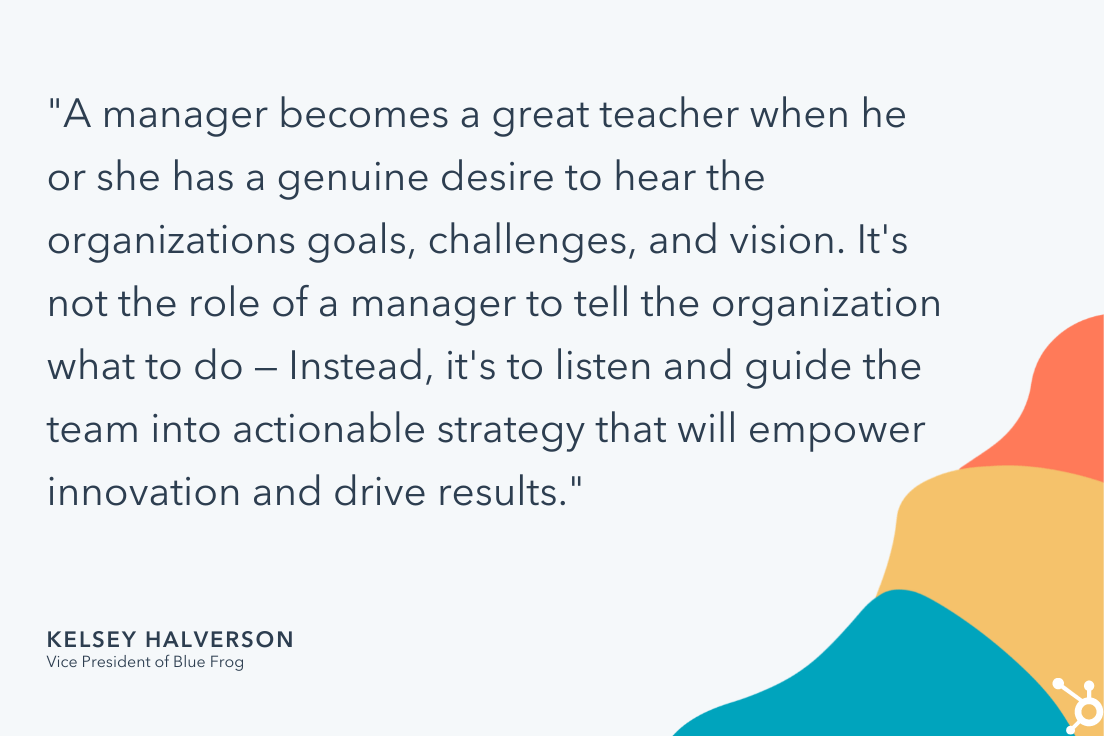Good leadership is vital for the long-term success of your organization.
Consider, for instance, how there’s a 56% reduction in burnout and 845% greater odds of employee engagement when leaders connect people to purpose, accomplishment, or each other.
Good leaders inspire and motivate their employees.
But it’s easier said than done. There are many ways to be a good leader, and it isn’t a one-size-fits-all approach.
If you’re unsure how to become a good leader, you’re in luck. Here, we’ll explore research-backed or expert-backed tips for becoming a better leader at work. Let’s dive in.
What does it mean to be a good leader?
While the term “good leader” can be difficult to define, it’s easy to spot in practice.
A good leader should have the following qualities:
- Resiliency
- Optimism
- Flexibility
- Integrity
- Accountability
- Empathy
- Humility
- Vision
Additionally, when we surveyed 300 people across the U.S., 44% respondents marked “Ability to communicate” as the most important trait/skill of a good leader. Strong communication skills came ahead of resiliency, creativity, humility, and even self-awareness.
Ultimately, a good leader is meant to inspire, motivate, and challenge each team member to hit their goals, impact the business’ bottom-line, and reach their fullest potential.
In his TedTalk “Why good leaders make you feel safe”, Management theorist Simon Sinek says a good leader is someone who makes their employees feel safe and secure.
Learn more about what makes an effective leader — according to experts at HubSpot, Google, LinkedIn, and Monday.com — in this post on developing leadership skills.
Fortunately, leadership isn’t a trait that you’re either born with or you’re not. Instead, good leadership skills can be learned. Let’s explore how to become a better leader, next.
How to Be a Better Leader at Work
1. Take a leadership assessment.
The first step towards becoming a better leader is assessing your personal strengths and weaknesses to understand areas for improvement.
Start by taking a leadership style quiz to determine which of the 8 leadership styles fits how you lead. Understanding your leadership style can help you determine how your direct reports view you, as well as the gaps that might exist in your current style.
For instance, let’s say you determine you’re an autocratic leader. An autocratic leader doesn’t ask for input from any team members before making a final decision — which can be ineffective, since it inhibits the leader from hearing different perspectives, and doesn’t empower his or her employees.
Once you’ve determined this is your leadership style, you can work to actively request input from team members — which enables employees to feel heard and empowered, while also helping you ensure you have all the information necessary before making a decision.
2. Be transparent and create open dialogue.
Ultimately, transparency and honesty leads to a higher level of trust between team members and leaders, so remaining transparent with your direct reports is critical.
Your direct reports want to know what’s happening with the organization at-large, so taking the time to have direct, honest conversations with them about the company’s goals is key.
For instance, if your department is going through a re-org, take the time to explain to each direct report why the re-org is taking place, and make space for each employee to express their concerns.
Being transparent and honest also encourages your direct reports to do the same. If they feel you hide information from them or aren’t forthcoming, they’ll act similarly — which can lead to confusion and an increased risk of miscommunication.
Good leaders are also excellent communicators. As Vice President of Blue Frog, Kelsey Halverson, told me, “Good managers teach, great managers listen. A manager becomes a great teacher when he or she has a genuine desire to hear the organizations goals, challenges, and vision.”
Halverson adds, “It’s not the role of a manager to tell the organization what to do — Instead, it’s to listen and guide the team into actionable strategy that will empower innovation and drive results.”
Taking the time to tailor your communication style for each direct report goes a long way towards establishing strong relationships with them. To do this, ask each direct report to complete a DiSC assessment, which will help you better understand each team member’s personality, how they respond to challenges, and how they prefer to communicate.
3. Foster deeper relationships with your team members.
Taking the time to learn who each of your team members are outside of work is vital for fostering a deeper relationship with them and establishing trust and understanding.
Consider using icebreaker questions during team meetings, or creating opportunities for the team to bond outside of work. Additionally, ask your direct reports about their preferred way to work — including communication styles, how they like to receive feedback, and what their professional goals are.
Finally, building rapport is about taking the time to get to know each direct report. In 1:1s, rather than jumping right into your meeting’s agenda, consider beginning the conversation more naturally by asking about your direct report’s weekend plans, or what she enjoys doing outside of work, all of which helps you both relate on a more human-to-human level.
4. Encourage professional development.
According to LinkedIn’s 2019 Workforce Learning Report, 94% of employees say they would stay at a company longer if it simply invested in helping them learn.
Providing your team members with learning and development opportunities can help you reduce turnover rates and increase employee engagement.
Being a good leader is all about seeking out learning and development opportunities for your direct reports, encouraging them to learn, grow, and face new challenges.
Additionally, it will help you make your team more successful in the long-run if you can help team members up-skill in certain areas, or nurture their own leadership skills as your team expands.
5. Show appreciation for a job well done.
Feeling recognized for a job well done can help boost an employee’s morale, engagement, and productivity.
For instance, consider the last time your boss gave you specific and positive feedback, such as, “You did a great job on your presentation on Tuesday. You gave fantastic context into the problem we’re trying to solve on the team, and you were clear and articulate about your proposed solutions.”
Not only would that make you feel great, but I’m willing to bet it would encourage you to work just as hard on your next presentation for more of that positive reinforcement.
Research has shown positive reinforcement is incredibly effective at ensuring people’s behaviors are repeated. So, if your employees do a good job, you’ll want to praise or reward them for their efforts to ensure your team continues to stay engaged and motivated.
6. Remain creative and open-minded.
Good leaders are innovative, creative, and open-minded to new ideas or processes. Rather than adhering to the status quo, a good leader constantly looks for ways to streamline processes, create new opportunities for their team, and increase impact on the bottom-line.
Good leadership includes taking a big-picture vision or strategy, and assigning specific tasks to individual team members to inspire, motivate, and challenge your team.
For instance, last year my manager recognized we needed a new process when it came to working with guest contributors. Once she’d recognized this big-picture challenge, she assigned the project to me. I was excited to own the creative process of brainstorming a new strategy, which kept me engaged and motivated at work.
How to Be a Positive Leader
People with positive moods have been proven to be more creative and collaborative, so if you’re able to spark positivity among your team, you’ll see a real impact on results.
Positivity is contagious, so being a positive leader can go a long way towards instilling confidence, pride, and happiness in your team members.
To be a positive leader, you’ll want to:
- Focus on an employee’s strengths and provide positive feedback in 1:1s
- Cultivate positive relationships with your team members
- Ignite hope by painting a picture of an exciting vision for the future, and consistently reminding employees of why their work matters
However, it’s important to note: You don’t want to prioritize positivity over reality.
As Senior Manager of HubSpot Blog Program’s Karla Hesterberg told me, “I think the best leaders balance realism and optimism really well. You want to keep your team feeling positive about the direction you’re headed, but you can’t gloss over challenges — you have to acknowledge when things are tough and give your team space to feel those things.”
Hesterberg says, “You can’t try too hard to put a positive spin on everything or you’ll end up minimizing real challenges.”
Hesterberg adds, “The best leaders I’ve worked with are really skilled at acknowledging the tough things but then convincing everyone to stay on the train anyway because where you’re all headed is great.”
Good leadership doesn’t happen overnight, and a good leader is humble enough to admit they’re not always going to get it right. There are setbacks in any leadership position.
Being self-aware, open to feedback, and flexible in your approach will set you up for more success in the long-run, particularly as your team grows, or your business’ needs change.
Go to Source
Author: Caroline Forsey
![→ Click here to download leadership lessons from HubSpot founder, Dharmesh Shah [Free Guide].](https://no-cache.hubspot.com/cta/default/53/4e634041-e1ce-4a85-8e65-aea12fc10b84.png)



